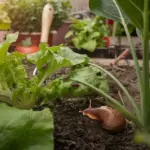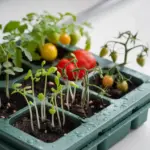Drainage and Moisture Management

Let me tell you about the time I completely flooded my vegetable garden. It was a disaster that taught me everything I know now about proper drainage! After watching my precious tomato plants practically drown in a pool of standing water, I realized that managing moisture isn’t just about watering – it’s about creating the perfect balance.
The Goldilocks Zone of Soil Moisture
The secret to successful vegetable gardening is finding what I like to call the “Goldilocks zone” of soil moisture – not too wet, not too dry, but just right. My soil moisture meter has become my best friend in the garden. When I first started, I used to just stick my finger in the soil, but trust me, that method led to more than a few waterlogged disasters.
The key is understanding that different vegetables have different moisture needs. For instance, my leafy greens love consistent moisture, while my root vegetables prefer slightly drier conditions. I learned this the hard way after drowning my poor carrots!
Creating the Perfect Drainage System
Here’s something that blew my mind: adding just a 2-inch layer of organic matter can improve your soil’s water retention by up to 30%! After dealing with puddles in my garden beds, I discovered that proper drainage starts from the bottom up.
My go-to drainage solution involves:
- Creating a slight slope in garden beds (about a 2% grade)
- Adding a layer of gravel at the bottom of raised beds
- Incorporating plenty of compost to improve soil structure
- Installing drainage pipes for particularly problematic areas
Managing Different Soil Types
Working with clay soil? Been there! It was like trying to garden in concrete when it dried out. The game-changer was adding gypsum and organic matter. For sandy soil, I’ve found that adding coconut coir works wonders for water retention.
Here’s my tried-and-true moisture management strategy for different soil types:
- Clay soil: Add gypsum and coarse sand
- Sandy soil: Incorporate coconut coir and compost
- Loamy soil: Maintain with regular organic matter additions
Smart Irrigation Practices
After wasting countless gallons of water (and dollars on my water bill), I finally got smart about irrigation. Drip irrigation has literally changed my gardening life. It delivers water directly to the roots, where plants need it most, and I’ve seen a 40% reduction in my garden water usage.
The best time to water is early morning, between 5 AM and 9 AM. This gives plants time to absorb moisture before the heat of the day kicks in. I set up my timer system accordingly, and my vegetables have never been happier!
Want to know something cool about preventing waterlogging? I installed a rain gauge and connected it to my irrigation system. Now my garden waters itself based on actual rainfall data. Talk about working smarter, not harder!
Ready to take your garden to the next level? In the next section, we’ll dive into “Optimizing Soil Health” where I’ll share my secret weapon for creating super-charged soil that practically grows vegetables on its own! Just hit that next button below to discover how beneficial microorganisms transformed my garden from good to absolutely amazing. Trust me, you won’t want to miss my story about the time I accidentally created a bacterial bloom that made my tomatoes grow like crazy!









GIPHY App Key not set. Please check settings